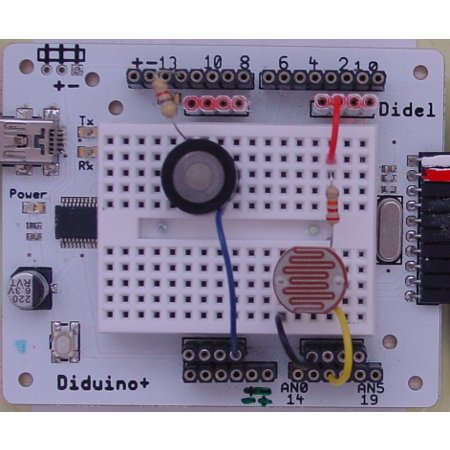|
Replacement product: 33363
The Diduino board from Didel is an Arduino Duemilanove/Freeduino compatible clone board and it's mainly made in Switzerland.
The Diduino like many others is based on the ATmega328P and uses an FTDI232 for USB communication and sketch uploading. It comes preloaded with the Duemilanove bootloader and can be easily programmed like one directly from the Arduino IDE.
Didel designed this board for users who already have an application that works on their Arduino/Diduino and who want to wire it in a more definitive manner, still keeping the advantage of reprogramming the modifications easily thanks to the USB connection.
The square field in the middle has been kept empty intentionally to make it possible to stick a mini-breadboard directly on the board which is great if your workspace is limited.
Didel made a nice innovation on the Pin13 LED, it also connects to an onboard button. Depending on the usage of the pin as input or output, the LED or the button can be used:
Noticed the red circle about the Vref pin ? That's because with the Diduino the Vref pin is wired to Vcc and not the Vref Pin of the ATmega328. Make sure your application does not use this pin!
The Diduino board is quite different in some aspects compared to the mass of clones we know. Please make sure you understand the differences to a regular Arduino board outlined below before you order a Diduino:
Differences / Non-Standard Arduino Features:
- Didel discourages the use of 9V batteries and has no regulator on board. The Vin pin is connected to +5V, as well the Vref pin, so there is a +5V on the other side of the board. Very few shields use the Vref pin, but please check before using the Diduino board with another shield.!
- A power connector is provided at the top left corner, specially usefull to connect a 3.7V Lipo battery. While developing an autonomous application, you can connect/disconnect USB keeping the 3.7V active. Understand the board is designed for low power applications, that are developped under the 5V USB, but run on 3AA batteries or 3.7V Lipo. There is a protection diode, but the voltage must be lower than 5.2 Volts if USB is still connected.
- Pin13 not only has a LED connected but also an onboard button. If you set the Pin to Output, the LED will be used, if you set it to Input you can use the button.
- The board provides two additional rows of VCC and GND pins so power can be supplied to a range of devices directly from the board
- The board has no ICSP connector and is therefor not compatible with shields that need the ICSP connector like i.e. the Ethernet Shield.
- If the board needs to be reprogrammed, this can be done through the Didel ICSP miniature connector. An adapter is available toward the usual ISP connector.
- The Diduino board is partly Arduino shield compatible, depending on the use of the ICSP connector or the Vref pin, see above.
- The footprint of the board is slightly larger than a regular clone, so the board won't fit into the typcial 'Arduino enclosure'
- Total height of board is 6mm without headers mounted, fits great in low-profile enclosures
- There are four 3mm corner holes for mounting the board tightly and secure, plus two 3mm Arduino compatible holes for your shields.
- No onboard Vreg, the board relies on getting proper 3.5 - 5.5V from USB or external supply.
Note: The Diduino board comes with female headers assembled and ready to use.
The Diduino board is used on the Diduino Starter kit, successful in the French part of Switzerland. It will be announced later when the documentation in English and German will be available.

Documents:
|








